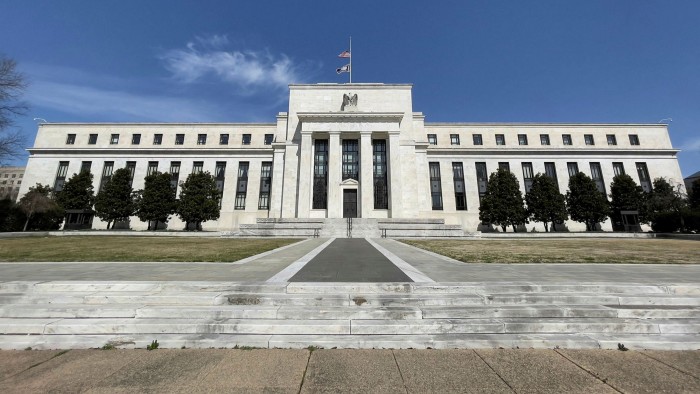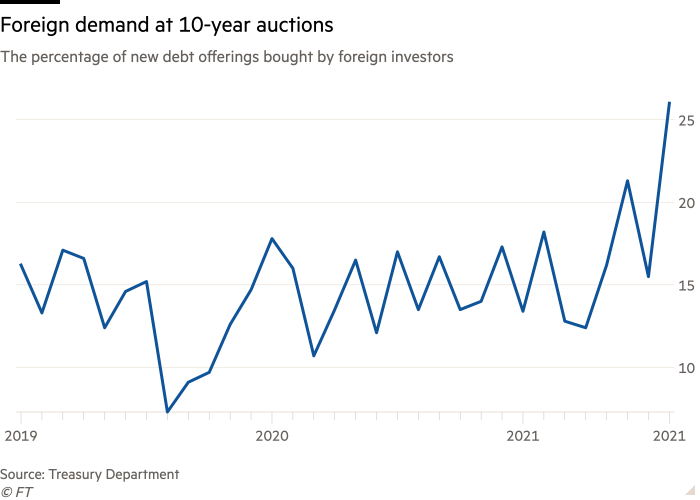Foreign investors help prop up Treasury market as Fed considers retreat

Roula Khalaf, Editor of the FT, selects her favourite stories in this weekly newsletter.
Foreign investors cannot get enough US government debt, which analysts say could help soften the blow when the Federal Reserve starts to cut back its own bond-buying programme this year.
Overseas buyers snapped up more than a quarter of the $41bn of 10-year notes on offer in August, the highest percentage in three years. At the equivalent auction in July, foreign investors took 16 per cent. At the two-year auction in August, investors bought 22 per cent, the highest since December 2019.
The high level of demand has meant that even as Fed chair Jay Powell in August signalled the central bank could begin to curtail its $120bn of monthly government debt purchases this year if inflation and employment figures continue to rise, Treasuries have remained well supported.
Analysts at Société Générale noted that in spite of taper fears putting pressure on the market, foreign demand is contributing to a “supportive” dynamic for bonds, “which will likely continue to counteract any rise in yields”.
The upbeat demand shows that buyers remain drawn to the deepest, most easily tradable bond market in the world where yields, though skinny, still tower above many in Europe and Asia.
“It is still very attractive for global investors to buy Treasuries,” said Tom Graff, head of fixed income at asset manager Brown Advisory. “We expect foreign demand will remain quite strong for the foreseeable future.”

Demand has been particularly strong in recent months from China and Japan, the two biggest foreign holders of Treasuries, said Tiffany Wilding, North American economist at Pimco.
Data from the People’s Bank of China show the largest inflows into the country’s foreign reserves this year since 2013, with analysts noting that the country’s holdings of dollars are often used to then buy Treasuries.
Separate data from Japan’s Ministry of Finance show bank purchases of long-term debt, including Treasuries, were the largest in seven months in June. Despite the data showing selling activity in July and August, purchases are expected to pick up this month.
“The demand for Treasuries we see boils down to investors in Japan and China and it does look like there has been an uptick there when we look across a range of data sets,” said Wilding. “I think that’s going to be a continuing theme.”
This demand has kept prices high and yields low, even as economic data has improved and inflation has risen, and in spite of the flood of new debt from the US government — a net issuance of $4.3tn last year and $884.8bn through August this year, according to the Securities Industry and Financial Markets Association.
Many central banks in the developed world — and some in emerging markets too — launched bond-buying schemes to soften the blow of the coronavirus pandemic last year. In Europe, that has pulled yields on benchmark bonds in Germany, Switzerland and the Netherlands all below zero.
The US Federal Reserve’s programme had a global impact on markets, helping to support asset prices around the world and pulling yields down. Still, among G10 countries, the US 10-year Treasury note has the highest yield of any benchmark at 1.36 per cent, luring investors around the world.
As doubt over the intensity of the global economic recovery from the pandemic swirls, investors seeking safe assets have gravitated to the US.
“Continued uncertainty across the globe has made people want to be in liquid assets that benefit from uncertainty,” said Michael Cloherty, a rates strategist at UBS. “Buying Treasuries is a good hedge for the possible ugly outcomes.”
Treasury International Capital transaction data published on Thursday showed a net $10bn of buying from foreign investors in July, with bumper purchases from China and the Cayman Islands — considered a proxy for hedge funds — outweighing selling across Europe and Japan. It is the second consecutive month of inflows, but a relatively modest move — roughly $119bn was bought in March, a record high in the data set which goes back to 1979.
One possible obstacle for investors looking to buy Treasuries is the cost of borrowing dollars, but thanks to the flood of cash injected in to financial markets over the past year by central banks, that is not proving to be a problem, said Cloherty.
Rising foreign demand is “definitely something we are seeing more of in the data”, said Ben Jeffery, rates strategist at BMO Capital Markets. “I think this is a contributing factor to why we keep seeing waves of dip buying in Treasuries.”
Comments